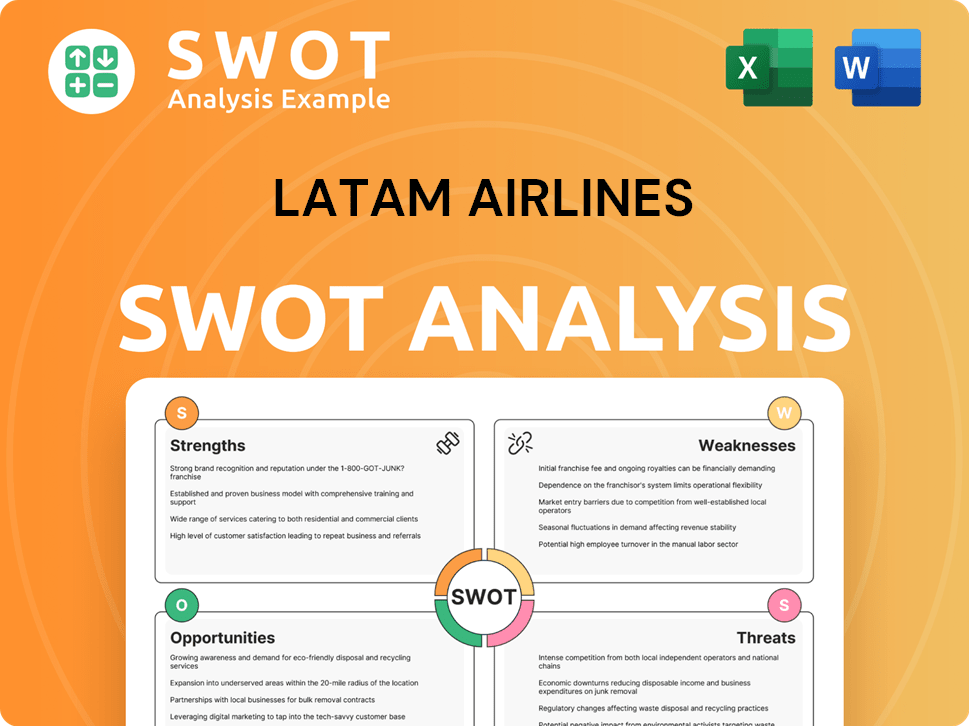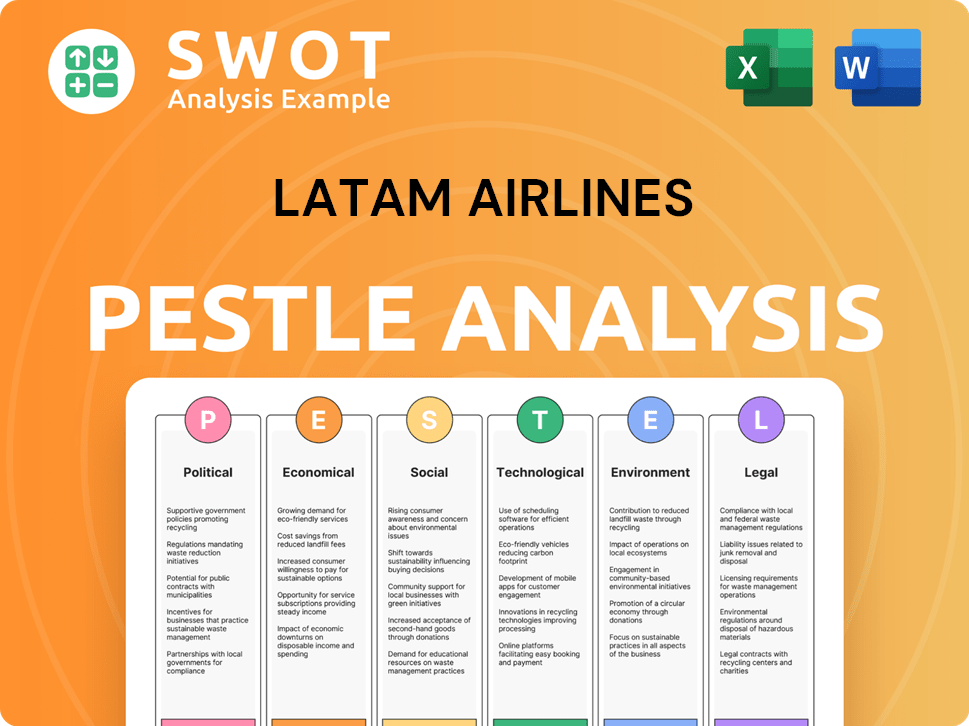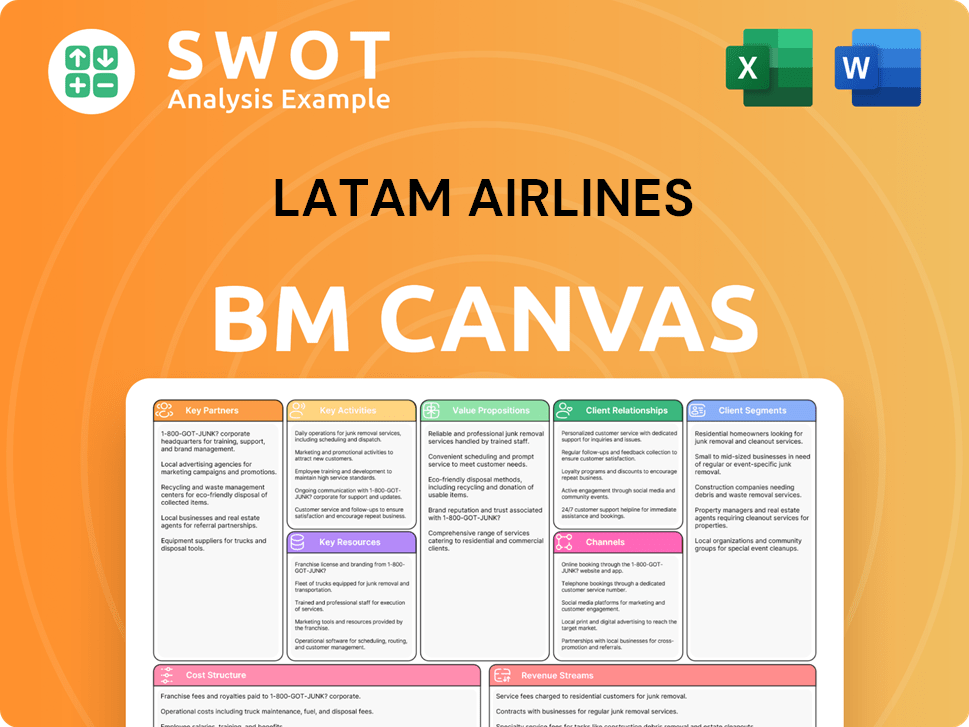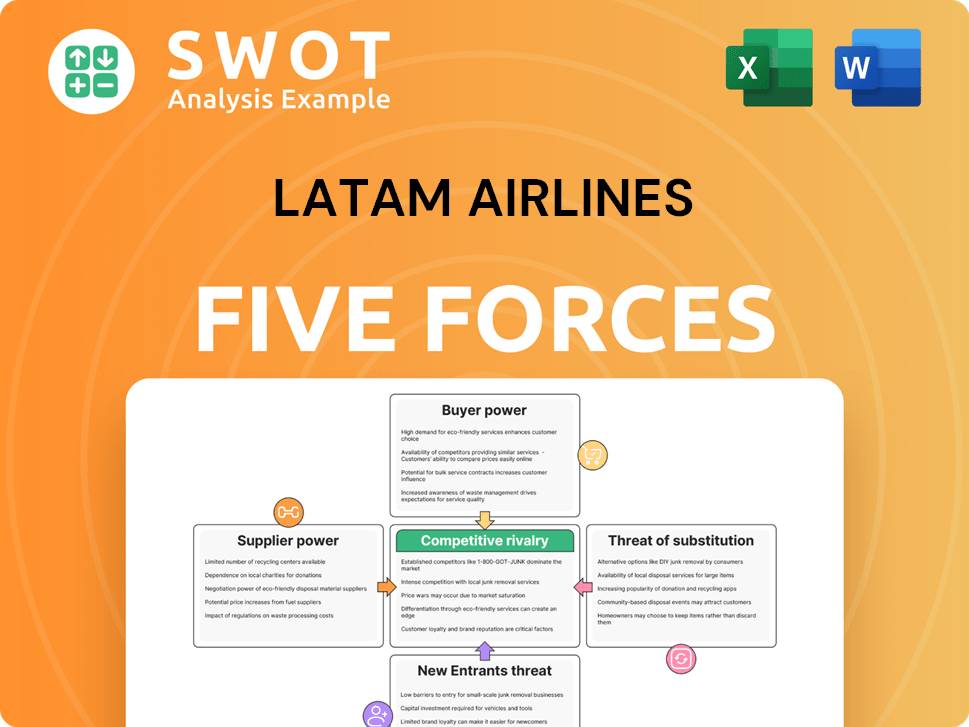Latam Airlines Bundle
Who Flies LATAM Airlines?
In the competitive skies of Latin America, understanding the Latam Airlines SWOT Analysis is crucial, but even more so is knowing its customers. For LATAM Airlines, grasping the nuances of its customer demographics and target market is not just about filling seats; it's about crafting a successful business strategy. This knowledge directly shapes the airline's ability to adapt to market changes and maintain its leading position in the industry.

LATAM's journey from a Chilean postal service to a pan-Latin American giant reveals the importance of knowing its Latam Airlines customer profile. The airline's evolution, including its response to the pandemic and its Chapter 11 bankruptcy, underscores the need to understand its diverse Latam Airlines passengers. This analysis will delve into the Latam Airlines market analysis, revealing who these customers are, where they come from, and what drives their travel choices, providing valuable insights into the airline's ongoing success and adaptation strategies for its Latam Airlines audience.
Who Are Latam Airlines’s Main Customers?
Understanding the customer demographics of the airline is crucial for its operational and strategic planning. The company caters to a diverse customer base, reflecting the varied populations across Latin America and the international destinations it serves. While specific details about the exact customer profile are not always publicly available, the airline's actions and expansions provide valuable insights into its target groups.
The airline serves both consumers (B2C) and businesses (B2B) across its extensive network. The company's focus on leisure and business travelers within key domestic markets and international routes highlights its strategic approach. This approach is further refined by the airline's cargo operations, which cater to businesses needing air transportation for goods.
The airline's customer base is broad, with a significant presence in several domestic markets, including Brazil, Chile, Colombia, Ecuador, and Peru. The airline also targets international travelers, particularly those traveling between Latin America and North America. This focus is evident in the airline's capacity increases and partnerships.
The airline's strong presence in Brazil, with over 47 million seats supplied in 2024, highlights its focus on this segment. The growth in domestic capacity, specifically a 13% increase in LATAM Airlines Brazil's domestic capacity in May 2025, shows the importance of this market. Intra-regional routes, such as the Lima-Santiago route, which was the busiest in Latin America in January 2025 with nearly 156,000 passengers, also indicate a significant segment of travelers moving between Latin American countries for leisure and business.
The airline targets international travelers, with a near 20% increase in international capacity year-on-year in 2024. The strategic boost in capacity to the North American market by 61% in 2024 compared to pre-Covid 2019 levels, and the inclusion of Argentina into the joint venture agreement with Delta Air Lines in April 2025, show a growing focus on connecting Latin America with North America.
Cargo operations represent a significant B2B segment, with cargo revenue showing robust growth of 9.8% in Q1 2025, reaching $406 million. This segment serves businesses requiring air transportation for goods across its network.
The airline has adapted its focus to market dynamics, including a post-pandemic recovery that saw strong passenger demand. For example, in May 2025, there was a slight decrease of 0.7% in domestic capacity for affiliates in Chile, Colombia, Ecuador, and Peru, due to strategic capacity reallocation towards the international segment. The expansion from 151 destinations in December 2024 to 153 destinations in 27 countries by March 2025, reflects a continuous effort to capture growing segments of travelers. To understand more about the airline's strategic moves, check out the Growth Strategy of Latam Airlines.
The airline's primary customer segments include leisure and business travelers within Latin America, international travelers connecting to North America, and businesses utilizing its cargo services. The airline's strategy involves adapting to changing market conditions and enhancing connectivity to meet the needs of these diverse groups. Understanding the airline's customer demographics Latam Airlines and Latam Airlines target market is crucial for investors and analysts.
- Leisure travelers within key domestic markets (Brazil, Chile, Colombia, Ecuador, and Peru).
- Business travelers within the same domestic markets and on international routes.
- International travelers, particularly those between Latin America and North America.
- Businesses requiring air cargo services.
Latam Airlines SWOT Analysis
- Complete SWOT Breakdown
- Fully Customizable
- Editable in Excel & Word
- Professional Formatting
- Investor-Ready Format

What Do Latam Airlines’s Customers Want?
Understanding the customer needs and preferences is crucial for the success of any airline. For the airline, this involves a deep dive into what drives their passengers to choose their services. Factors such as reliability, connectivity, comfort, and value are paramount in shaping customer decisions.
The airline's focus on operational excellence and customer satisfaction reflects its dedication to meeting these needs. The airline's Net Promoter Score (NPS) of 56 points in Q1 2025, the highest in the group's history, highlights a strong preference for positive interactions and service quality. This commitment to customer satisfaction is a key element in understanding the customer profile.
The airline's approach to meeting customer needs and preferences is multifaceted, encompassing various aspects of the travel experience. From offering diverse fare options to expanding its network and enhancing its loyalty programs, the airline continuously adapts to meet the evolving demands of its passengers. This proactive approach is vital for maintaining a competitive edge in the market and ensuring customer loyalty.
Customers prioritize a seamless travel experience, from booking to arrival. This focus is evident in the airline's operational excellence and customer satisfaction efforts.
The airline's efforts to enhance its network and offer improved connectivity within South America and to international destinations directly address the need for efficient travel options.
Customers value flexibility and tailored experiences, as demonstrated by the demand for various fare options, from economy to premium classes. This allows the airline to cater to a wide range of preferences.
Loyalty programs significantly influence customer behavior, with the LATAM Pass program reaching 49 million members in 2024. The evolution of the program with new bonuses responds to customer desires for rewards.
Customers are increasingly interested in sustainable travel options. The airline addresses this by incorporating new aircraft and offering CO2 compensation programs.
The expansion of free Wi-Fi for LATAM Pass members on domestic and regional flights directly addresses customer preferences for connectivity during travel. This is a key factor in the overall customer experience.
The airline's customer base, or its target market, is diverse, encompassing various demographics and preferences. The airline's initiatives, such as fleet retrofitting and targeted marketing campaigns, reflect a deep understanding of its passengers. For instance, the joint campaign with PROMPERÚ between April and June 2025 to promote tourism to specific Peruvian cities, targeting visitors from strategic markets, showcases a localized marketing approach. This campaign utilizes extensive digital outreach across platforms like Google, Meta, YouTube, TikTok, and DV360, reflecting an understanding of where and how to reach different customer segments. To further understand the airline's operations and financial performance, you can read more about it in Owners & Shareholders of Latam Airlines.
The airline's customers are driven by a mix of psychological, practical, and aspirational factors. These factors influence their choices when selecting the airline's offerings. Key needs and preferences revolve around reliability, connectivity, comfort, and value.
- Reliability: Customers prioritize on-time performance and dependable service.
- Connectivity: Efficient routes and seamless connections are highly valued.
- Comfort: Comfortable seating and a pleasant in-flight experience are essential.
- Value: Competitive pricing and attractive fare options are important.
- Seamless Experience: Customers seek a smooth journey from booking to arrival.
- Rewards and Perks: Loyalty programs and personalized benefits enhance the travel experience.
Latam Airlines PESTLE Analysis
- Covers All 6 PESTLE Categories
- No Research Needed – Save Hours of Work
- Built by Experts, Trusted by Consultants
- Instant Download, Ready to Use
- 100% Editable, Fully Customizable

Where does Latam Airlines operate?
The geographical market presence of LATAM Airlines Group is predominantly focused on Latin America, where it functions as the leading airline group. Its operations span five domestic markets: Brazil, Chile, Colombia, Ecuador, and Peru. Additionally, it has an extensive international network that includes routes within Latin America and to destinations in Europe, the United States, Oceania, Africa, and the Caribbean.
A significant portion of LATAM's operations are concentrated in South America, reflecting substantial domestic operations. Its international market reach is strategically allocated, leveraging key hubs to optimize connectivity. This strategic approach is crucial for understanding the airline's customer demographics and how it targets its market.
The airline's strategic focus on key hubs and routes is a critical element of its operational strategy. Understanding the geographical distribution of LATAM's customers and the airline's ability to adapt to regional preferences is key to its success. For more insights into the financial aspects, you can explore Revenue Streams & Business Model of Latam Airlines.
Brazil is LATAM's largest market, with over 47 million seats supplied in 2024. Sao Paulo Guarulhos (GRU) is the largest hub, holding a 52% share of all capacity there. LATAM is the predominant airline in Chile, Ecuador, and Peru, and the largest carrier in Brazil.
Key hubs include Santiago International (SCL) in Chile and Jorge Chávez International Airport (LIM) in Lima, Peru. Secondary hubs are located in Bogotá, Quito, Guayaquil, and Asunción. About 79% of LATAM's seats to Europe are served from its São Paulo Guarulhos hub.
LATAM increased capacity to the North American market by 61% in 2024 compared to pre-Covid 2019 levels. In April 2025, the inclusion of Argentina into the Joint Venture Agreement with Delta Air Lines strengthened connectivity. New routes, like São Paulo (Guarulhos) to Fernando de Noronha, are continuously launched.
In Q1 2025, revenue increased by 2.7% year-over-year to $3.41 billion, with passenger revenue growing by 1.6% to $2.94 billion. LATAM transported nearly 21 million passengers in Q1 2025, a 3.6% increase compared to the same period last year. In 2024, LATAM transported a record 82 million passengers.
LATAM Airlines' customer demographics and market strategies are closely tied to its geographical presence. The airline tailors its offerings to meet the specific needs of its passengers in different regions. This includes adjusting routes, services, and marketing efforts to resonate with local preferences and buying power.
- Brazil: Remains the largest market, with significant domestic operations.
- Hub Strategy: Utilizes key hubs like São Paulo and Santiago to optimize international connectivity.
- North America Expansion: Increased capacity to the North American market by 61% in 2024.
- Route Development: Continuously launches new routes to enhance connectivity and tap into new markets.
- Financial Growth: Shows strong performance in Q1 2025 with increased revenue and passenger numbers.
Latam Airlines Business Model Canvas
- Complete 9-Block Business Model Canvas
- Effortlessly Communicate Your Business Strategy
- Investor-Ready BMC Format
- 100% Editable and Customizable
- Clear and Structured Layout

How Does Latam Airlines Win & Keep Customers?
To attract and retain customers, the airline employs a variety of strategies. These include digital marketing, strategic route expansions, and loyalty programs. The goal is to enhance the overall customer experience and foster long-term relationships. The airline's approach is data-driven, using customer insights to make smarter decisions and develop innovative solutions.
Digital marketing utilizes platforms such as Google, Meta, YouTube, TikTok, and DV360 for extensive digital outreach. Sales tactics involve strategic route expansion and increased capacity to meet growing demand. Loyalty programs, particularly the LATAM Pass, are central to retention efforts, with personalized benefits and simplified earning processes to encourage continued engagement. The airline also focuses on personalized experiences, such as fleet retrofitting and free Wi-Fi, to enhance customer satisfaction and loyalty.
The airline's commitment to data-driven decision-making is evident in its digital transformation efforts. Customer relationship management (CRM) systems help segment customers and tailor campaigns. The airline’s strategic reallocation of capacity aligns with market demand. These efforts have contributed to strong financial and operational performance, as demonstrated by record passenger numbers and a high Net Promoter Score (NPS) in 2024.
The airline uses digital platforms like Google, Meta, YouTube, TikTok, and DV360 for digital marketing. They also use mass email marketing to reach a broad audience. A joint campaign with PROMPERÚ in 2025 to promote tourism to Peru is a prime example.
Strategic route expansion and capacity increases are key tactics. For example, in May 2025, LATAM Airlines Brazil increased its domestic capacity by 13%. The new route from São Paulo to Fernando de Noronha is a key acquisition strategy.
The LATAM Pass frequent flyer program, with 49 million members in 2024, is a central retention tool. In January 2025, 'LATAM Pass Bonuses' were launched to personalize the experience for frequent flyers. Simplifying earning Qualifying Points in 2025 also boosts retention.
The airline focuses on providing personalized experiences. Fleet retrofitting, with 100% of narrow-body and 54% of wide-body aircraft renovated by 2024, enhances customer satisfaction. Free Wi-Fi for LATAM Pass members is another enhancement.
The airline aims to be data-driven, using customer insights to make smarter decisions and develop innovative solutions. This includes using customer data and CRM systems to segment customers and tailor campaigns effectively. The airline’s strong financial and operational performance in 2024, with a record 82 million passengers transported, indicates the effectiveness of these strategies.
- The airline's customer base includes a wide range of demographics, with a focus on the South American market.
- Understanding the Brief History of Latam Airlines can provide context for its customer acquisition and retention strategies.
- The airline's target market is diverse, including business and leisure travelers.
- Customer segmentation strategies are used to tailor marketing efforts and enhance customer lifetime value.
Latam Airlines Porter's Five Forces Analysis
- Covers All 5 Competitive Forces in Detail
- Structured for Consultants, Students, and Founders
- 100% Editable in Microsoft Word & Excel
- Instant Digital Download – Use Immediately
- Compatible with Mac & PC – Fully Unlocked

Related Blogs
- What are Mission Vision & Core Values of Latam Airlines Company?
- What is Competitive Landscape of Latam Airlines Company?
- What is Growth Strategy and Future Prospects of Latam Airlines Company?
- How Does Latam Airlines Company Work?
- What is Sales and Marketing Strategy of Latam Airlines Company?
- What is Brief History of Latam Airlines Company?
- Who Owns Latam Airlines Company?
Disclaimer
All information, articles, and product details provided on this website are for general informational and educational purposes only. We do not claim any ownership over, nor do we intend to infringe upon, any trademarks, copyrights, logos, brand names, or other intellectual property mentioned or depicted on this site. Such intellectual property remains the property of its respective owners, and any references here are made solely for identification or informational purposes, without implying any affiliation, endorsement, or partnership.
We make no representations or warranties, express or implied, regarding the accuracy, completeness, or suitability of any content or products presented. Nothing on this website should be construed as legal, tax, investment, financial, medical, or other professional advice. In addition, no part of this site—including articles or product references—constitutes a solicitation, recommendation, endorsement, advertisement, or offer to buy or sell any securities, franchises, or other financial instruments, particularly in jurisdictions where such activity would be unlawful.
All content is of a general nature and may not address the specific circumstances of any individual or entity. It is not a substitute for professional advice or services. Any actions you take based on the information provided here are strictly at your own risk. You accept full responsibility for any decisions or outcomes arising from your use of this website and agree to release us from any liability in connection with your use of, or reliance upon, the content or products found herein.